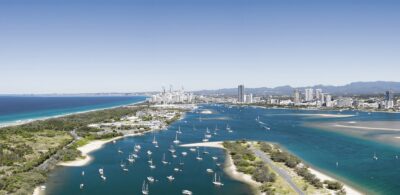Accommodating the rise of Airbnb: Queensland councils can increase rates for short-term accommodation
15 March 2021
In the past ten years, cities around the world have had to come to terms with a significant shift in the way people use accommodation on their holidays. Services such as Airbnb offer travellers the opportunity to experience a city in a more ‘local’ setting, while allowing local residents to gain an alternative source of revenue from their own home.
Uses of residential properties for ‘tourism’ purposes may place additional strain on local government infrastructure where that infrastructure was not designed to accommodate that extra demand generated by tourists.
Meanwhile, landowner ‘hosts’ may have been able to benefit from the additional revenue of these services without having to provide a fair contribution for the additional burden placed on local government infrastructure.
One means to address these issues may be through levying higher rates for residential properties used for tourism purposes. A recent decision of the Queensland Court of Appeal, Island Resorts (Apartments) Pty Ltd v Gold Coast City Council [2021] QCA 19, has confirmed that local governments have the power to levy differential rates for properties depending on whether the land is used for permanent or itinerant accommodation.
Key points
- Island Resorts (Apartments) Pty Ltd (Island Resorts) owns 70 residential properties on South Stradbroke Island, used primarily as tourist accommodation.
- Island Resorts challenged Gold City Council’s (Council) decision to levy differential rates based on whether properties were rented to ‘permanent residents’ or ‘itinerants’, but was unsuccessful in the Supreme Court of Queensland.
- On appeal, Island Resorts again contended that Council was not entitled to levy rates based on the ‘personal characteristics’ of occupants, i.e. whether they were permanent residents or itinerants.
- However, the Court of Appeal confirmed the Supreme Court’s decision, explaining that the Local Government Act 2009 (Qld) (LGA) does not restrict local governments from having regard to these characteristics, meaning the Council’s decision was valid.
Background to appeal
Council’s Revenue Statement and Resolution of Rates and Charges levied differential rates for residential properties. Rates levied on properties used for permanent rental accommodation for residents were lower than the rates levied on properties used for rental accommodation for itinerants.
The background to this appeal and the decision of the Supreme Court was recently discussed here.
Appeal to the Queensland Court of Appeal
After unsuccessfully challenging Council’s decision in the Supreme Court, Island Resorts appealed to the Queensland Court of Appeal.
Island Resorts argued that the Supreme Court made an error, and should have concluded that the levying of differential rates based on the status of the occupants was unrelated to a characteristic of the land.
Island Resorts contended that Council instead had regard to an ‘irrelevant consideration’, being the personal characteristics of the occupier – meaning its decision was invalid.
This argument relied on the earlier Court of Appeal decision of Xstrata Coal Qld Pty Ltd v Council of the Shire of Bowen,[1] which Island Resorts said was authority for the proposition that Council could only have regard to a characteristic of the land (not the occupier).
Island Resorts also pointed to the case of Paton v Mackay Regional Council,[2] in which the Supreme Court overturned a decision to impose differential rates based on whether land was occupied by the owner or an investor.
The Court of Appeal rejected Island Resorts’ arguments. The Court held that the LGA gives local governments a broad and general power to levy rates, without requiring a connection to a characteristic of the land. In particular, Section 94(1A) expressly permits rates to be levied based on whether land is the owner’s principle place of residence – but does not otherwise limit a local government’s power.[3] The Court did not accept that the Xstrata decision meant that a local government could only levy rates by reference to a characteristic of the land.
The Court also explained that the use of the land is a relevant consideration. It noted that Section 81 of the Local Government Regulation 2012 (Qld) provides for examples of differential rates, most of which are defined by reference to the use of that land.
The Court of Appeal confirmed Council’s decision to levy these differential rates and dismissed the Island Resorts’ appeal.
Lessons for local government
This decision confirms that Queensland local governments’ powers to levy rates are broad, and they may have regard to land use in deciding the appropriate amount of rates.
The power to levy differential rates depending on the use of the land is appropriate, as different uses will generate different demand on local government services. To require local governments to levy equal rates for different uses would therefore fail to equitably distribute the rate burden.
The decision also offers an option for local governments to regulate the use of residential properties for tourism purposes, outside of the development assessment process.
The use of residential properties for tourism purposes may not trigger any requirement for development assessment, and the development assessment process may not always be the best means of regulating the impacts of service providers such as Airbnb. Instead, local governments may decide instead that the extra demand on local infrastructure from such services should be regulated by levying differential rates, with a higher rate applying to those properties used for tourism purposes.
The difficulty will be determining which properties should be subject to a different rating category, without trawling through the accommodation offerings of service providers on a regular basis to determine which properties are being offered for short-term accommodation.
Another complicating factor will be the extent to which the property is actually used for tourism purposes. For example, if a property is used as a permanent place of residence for most of the year, but rented out through Airbnb for only a couple of weeks each year, that will likely not be sufficient for a local government to rate the property for tourism purposes. But where is the threshold and how would local governments ‘regulate’ the extent of the short-term accommodation?
[1] [2010] QCA 170.
[2] [2014] QSC 75.
[3] This section was introduced in response to the Paton decision.
Authors

Partner

Senior Associate
Tags
This publication is introductory in nature. Its content is current at the date of publication. It does not constitute legal advice and should not be relied upon as such. You should always obtain legal advice based on your specific circumstances before taking any action relating to matters covered by this publication. Some information may have been obtained from external sources, and we cannot guarantee the accuracy or currency of any such information.


